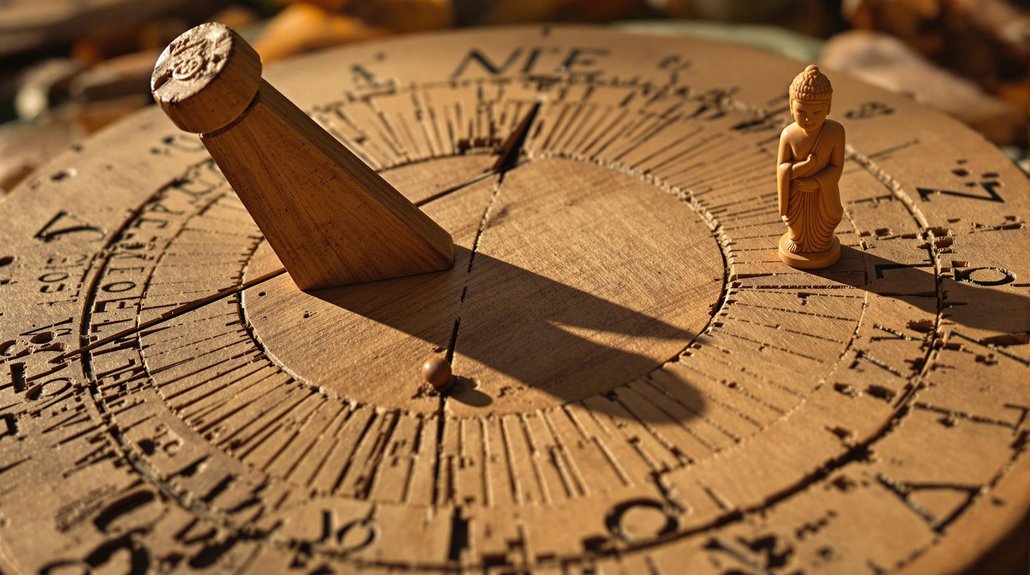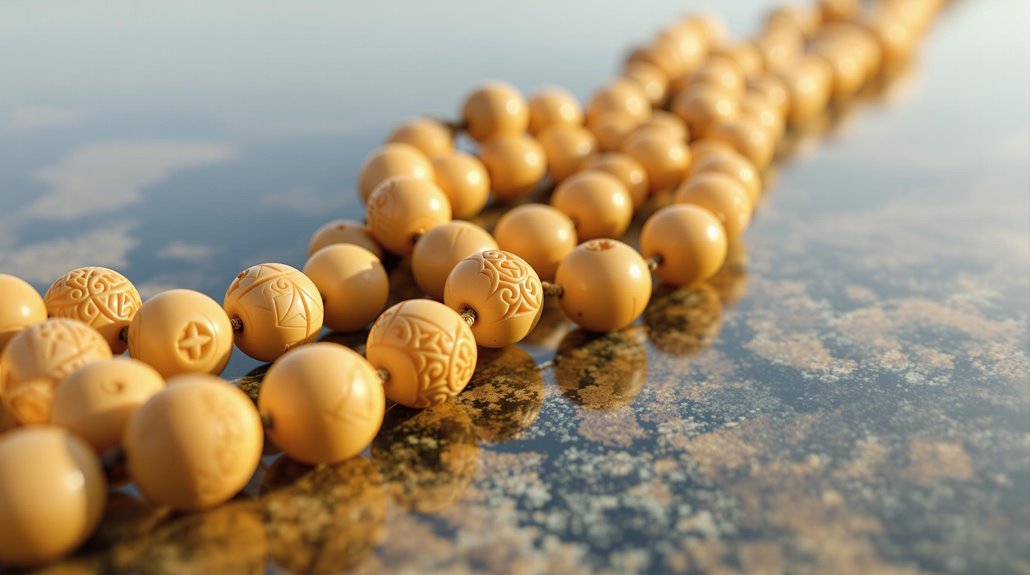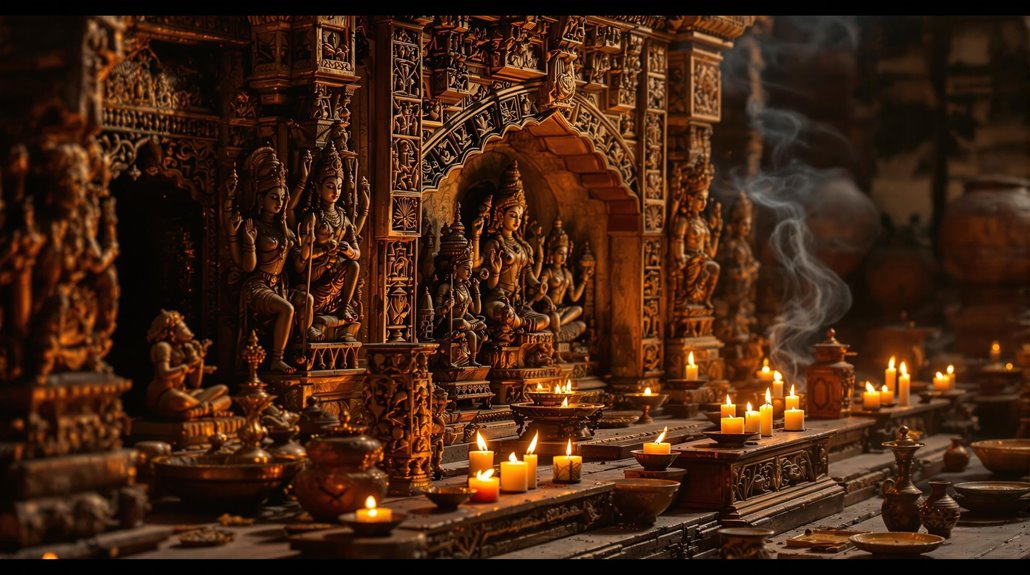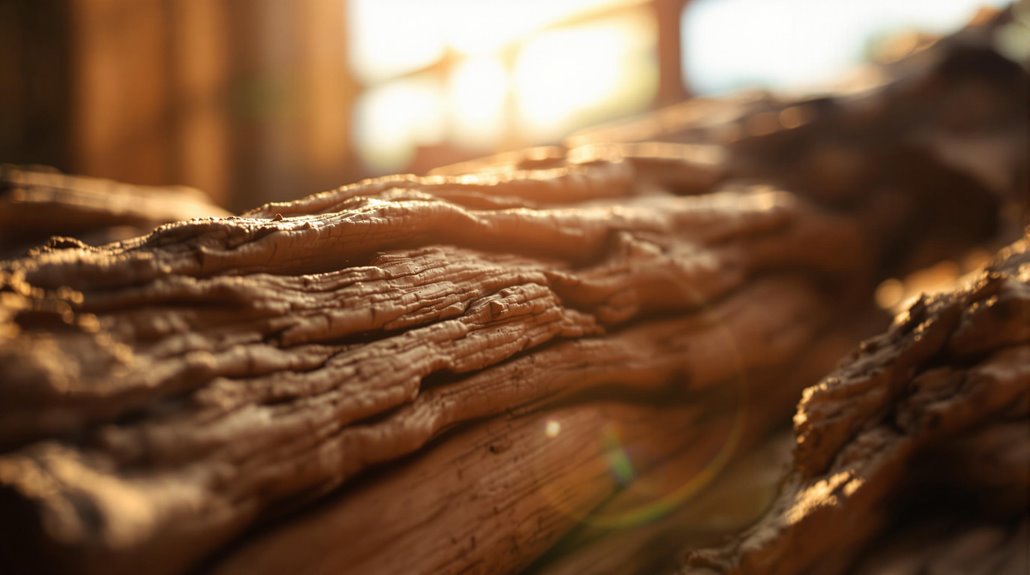How Sandalwood Was Used in Ancient Timekeeping Devices

Sandalwood's alluring fragrance and steady combustion made it an indispensable ancient timekeeping tool. You'll find it used across civilizations - from synchronizing celestial phenomena and religious rituals in ancient India, to powering the intricate sandalwood clocks crafted by the Han dynasty. Sandalwood's exceptional water absorption rate and thermal conductivity enabled more precise water clocks, while its natural resistance to weathering and workability lent elegance and accuracy to sundial designs.
Sandalwood's versatile properties didn't just facilitate timekeeping - they hint at the rich history you'll uncover as you investigate its critical role in the development of early timekeeping technologies.
The Fragrant Properties of Sandalwood
Across centuries, the fragrant properties of sandalwood have enthralled cultures worldwide. This aromatic wood, cherished for its soothing, woody scent, has long been revered for its natural timekeeping properties. The slow, steady burn of sandalwood incense sticks has been used to track the passage of time, with the fragrance dissipating at a predictable rate.
The unique aromatic qualities of sandalwood stem from its high content of aromatic compounds, including alpha-santalol and beta-santalol. As the wood burns, these compounds are released into the air, creating a warm, comforting aroma that lingers in the environment. This steady, consistent release of fragrance allowed ancient civilizations to rely on sandalwood as a natural timekeeper, measuring the passage of time through the gradual diminishment of the scent.
Beyond its practical applications, the alluring fragrance of sandalwood has also been prized for its meditative and spiritual properties, making it an esteemed resource in religious and cultural practices throughout history. Its natural calming effects have been scientifically proven to reduce anxiety and stress levels in various therapeutic applications.
Sandalwood in Ancient Indian Timekeeping
The steady burn of sandalwood incense sticks played a vital role in ancient Indian timekeeping practices. Sandalwood's natural fragrance and consistent combustion made it an essential tool for tracking the passage of time.
- Sandalwood's use in ancient Indian calendars allowed for the accurate recording of days, months, and seasons. Its slow and steady burn provided a trustworthy indicator of time's flow.
- Sandalwood's role in recording astronomical phenomena was equally indispensable. The measurement of celestial events, such as the rising and setting of the sun and moon, depended on the consistent timing afforded by this aromatic wood.
- Sandalwood's versatility extended to religious and cultural rituals, where its measured burning synchronized the ebb and flow of sacred ceremonies, reinforcing the interconnectedness of time, nature, and the divine.
Sustainable cultivation of sandalwood trees has become crucial as this precious timekeeping resource faces declining populations due to overharvesting.
Sandalwood Clocks of the Han Dynasty

While ancient Indian timekeeping relied heavily on the steady burn of sandalwood, the Han Dynasty of China took this concept a step further, crafting intricate sandalwood clocks that enthralled the imagination of their time. These noteworthy timepieces were the result of the Han's expertise in sandalwood manufacturing techniques, honed through centuries of trade and cultivation along the Silk Road.
The process began with carefully selected sandalwood logs, their aromatic properties and fine grain diligently preserved through skilled carving and polishing. The wood was then precisely shaped into gears, wheels, and other intricate components, assembled with incredible precision to create clocks that tracked time with remarkable accuracy.
The sandalwood trade routes that connected China to the outside world facilitated the exchange of ideas and technologies, allowing the Han to raise this ancient timekeeping method to new heights. These clocks not only served as practical tools, but also as symbols of the Han's cultural and technological sophistication, fascinating all who laid eyes upon them.
The craftsmen needed to wait approximately 10 years of growth before the sandalwood trees developed the fragrant trunks suitable for creating these specialized timepieces.
Sandalwood and the Water Clock's Evolution
Alongside the intricate sandalwood clocks, the Han Dynasty also witnessed the evolution of another ancient timekeeping device - the water clock. This ingenious device capitalized on sandalwood's unique properties, including its exceptional water absorption rate and thermal conductivity.
- Sandalwood's ability to slowly release absorbed water allowed for a steady, consistent flow that could be painstakingly measured and marked. This enabled the water clock to provide a more precise time measurement compared to earlier iterations.
- The wood's thermal conductivity also played an essential role, as it helped regulate the water temperature, ensuring a stable flow rate and minimizing fluctuations that could disrupt the timekeeping.
- Additionally, the use of sandalwood in the water clock's construction lent an air of elegance and craftsmanship, perfectly in line with the Han Dynasty's renowned artistry and attention to detail.
The durability of these devices was remarkable, as sandalwood trees needed to be at least 15 years old before they could be harvested for such specialized applications.
Sandalwood's Role in Sundial Design

Sandalwood's extraordinary properties also found their way into the design of another ancient timekeeping device - the sundial. The warm, aromatic wood's unique features made it an ideal material for sundial construction. Its natural resistance to weathering and ability to maintain a smooth surface over time guaranteed the sundial's accuracy wouldn't degrade. Sundial designers capitalized on sandalwood's workability, allowing them to craft intricate markings and features that were essential for timekeeping precision.
Sundial design principles relied heavily on the sun's position and the casting of shadows. Sandalwood's light color provided optimal contrast for shadow visibility, while its density enabled the creation of thin, precise gnomon components that cast accurate shadows. This attention to material selection and design exemplifies how ancients maximized every resource at their disposal to develop increasingly sophisticated timekeeping tools. Sandalwood's multifaceted utility emphasizes its valuable role in the evolution of ancient timekeeping technology. The dark reddish-brown color and distinctive texture of pure sandalwood made it easy for craftsmen to authenticate their material before beginning construction.
Sandalwood Incense and Hourglass Timekeeping
Frequently, the aromatic properties of sandalwood were employed in the design of another ancient timekeeping device - the hourglass. Sandalwood's slow, even combustion patterns were observed and used to create a consistent, reliable timepiece.
- The fragrant wood's gradual burning produced a steady, measurable rate of descent for the sand within the hourglass.
- Artisans would carefully monitor the sandalwood's aroma and adjust the hourglass's components to guarantee accurate timekeeping.
- These sandalwood-infused hourglasses were prized for their precision and the soothing, therapeutic effects of the wood's scent during prolonged use.
The steam distillation process was later developed to extract the valuable essential oils from sandalwood materials. The hourglass's dependence on sandalwood's unique properties demonstrates the ingenious ways ancient cultures tapped into the natural world to meet their needs for reliable timekeeping. Sandalwood's aroma and combustion patterns were crucial to the design and function of this essential tool.
Sandalwood's Thermal Characteristics for Timekeeping

The thermal properties of sandalwood made it an ideal material for ancient timekeeping devices. Its unique thermal expansion properties allowed it to be used as a temperature-dependent combustion mechanism. As the sandalwood stick burned, its length would gradually decrease at a predictable rate, determined by the ambient temperature. This temperature-dependent combustion enabled the creation of simple yet accurate hourglasses and other timekeeping tools.
Sandalwood's thermal expansion characteristics were essential for this application. As the stick warmed, it would expand linearly, allowing the user to measure time by the stick's diminishing length. This temperature-dependent behavior guaranteed the consistency and reliability of the timekeeping device, making it a precious asset in ancient societies that relied on precise time measurement for activities like religious ceremonies, agricultural practices, and trade.
The combination of sandalwood's thermal expansion properties and temperature-dependent combustion made it a versatile and effective material for ancient timekeeping, showcasing the ingenuity of early civilizations in exploiting natural resources for technological advancement. The Indian Santalum album variety was particularly valued for these devices due to its high concentration of aromatic compounds in the heartwood.
Sandalwood in Astronomical Timekeeping Instruments
Beyond its use in simple hourglasses, sandalwood found a more specialized application in ancient astronomical timekeeping instruments. Its unique thermal properties made it an ideal material for constructing devices that tracked the movements of celestial bodies with impressive accuracy.
- Sandalwood's astronomical applications included the creation of sun dials, where its slow, steady burn provided a reliable reference for measuring the passage of time.
- Leveraging sandalwood's temperature-responsive qualities, ancient scholars also incorporated it into water clocks, precisely regulating the flow of water through the device.
- Sandalwood's timekeeping innovations extended to astrolabes, intricate instruments that used the wood's thermal expansion to determine the position of stars and planets, aiding in spatial orientation and celestial observation.
Sandalwood's role in these ancient astronomical timekeepers showcased its versatility and the ingenuity of those who exploited its unique properties to advance the science of measuring time.
The wood's natural healing properties were well-known to ancient timekeepers, who often burned it during astronomical observations to maintain mental clarity and reduce stress.
Sandalwood and the Birth of Mechanical Clocks

Remarkably, sandalwood's unique properties extended even to the birth of mechanical clocks. Its dual properties of being both aromatic and durable made it a vital material for early timekeeping applications. Sandalwood's natural oils provided a consistent, slow-burning fuel, allowing for the precise measurement of time through the controlled release of incense. This, coupled with its resistance to wear and tear, made it an optimal choice for the intricate mechanisms of nascent mechanical clocks.
The timekeeping applications of sandalwood were not limited to its use as an energy source. Craftsmen also harnessed its workability to create the delicate gears and escapements that formed the heart of these early timekeepers. The wood's fine grain and stability allowed for the precise shaping and fitting of components, guaranteeing the reliable and accurate tracking of time. As mechanical clocks evolved, sandalwood's versatility ensured its enduring presence in these technological marvels of the past. The wood's ability to withstand strong winds and drought made it particularly valuable for outdoor timekeeping devices exposed to harsh weather conditions.
Preserving Sandalwood's Legacy in Timekeeping
Amidst the steady march of technological progress, it is essential to preserve sandalwood's enduring legacy in the domain of timekeeping. This fragrant wood, revered for its cultural significance and medicinal properties, has long played a pivotal role in the evolution of ancient timekeeping devices.
- Sandalwood's distinct aroma and slow-burning properties made it an ideal material for incense-based time-keeping mechanisms, such as the ancient Chinese incense clock. These intricate devices relied on the measured consumption of sandalwood sticks to track the passage of time, blending practicality with the spiritual and sensory experience.
- Beyond its use in timekeeping, sandalwood has also been instrumental in the development of mechanical clocks. The wood's durability and natural resistance to wear and tear made it a preferred choice for key components, ensuring the longevity and precision of these early timepieces.
- As modern technologies continue to advance, it is important to honor sandalwood's legacy by preserving its role in the rich tapestry of timekeeping history. By recognizing and celebrating this natural wonder, we can ensure that its influence endures, inspiring future innovations and reminding us of the enduring power of ancient wisdom. Similar to how magical practitioners use sandalwood to maintain focus during meditation, ancient timekeepers valued its ability to enhance concentration during precise time measurements.




